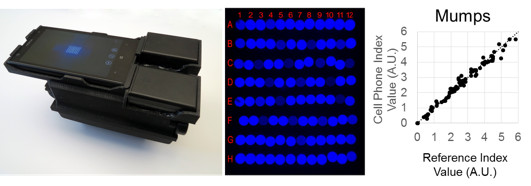Cellphone-Based Hand-Held Micro-Plate Reader for Point-of-Care Testing of Enzyme-Linked Immunosorbent Assays (2015)

Standard microplate based enzyme-linked immunosorbent assays (ELISA) are widely utilized for various nanomedicine, molecular sensing, and disease screening applications, and this multiwell plate batched analysis dramatically reduces diagnosis costs per patient compared to nonbatched or nonstandard tests. However, their use in resource-limited and field-settings is inhibited by the necessity for relatively large and expensive readout instruments. To mitigate this problem, we created a hand-held and cost-effective cellphone-based colorimetric microplate reader, which uses a 3D-printed opto-mechanical attachment to hold and illuminate a 96-well plate using a light-emitting-diode (LED) array. This LED light is transmitted through each well, and is then collected via 96 individual optical fibers. Captured images of this fiber-bundle are transmitted to our servers through a custom-designed app for processing using a machine learning algorithm, yielding diagnostic results, which are delivered to the user within ∼1 min per 96-well plate, and are visualized using the same app. We successfully tested this mobile platform in a clinical microbiology laboratory using FDA-approved mumps IgG, measles IgG, and herpes simplex virus IgG (HSV-1 and HSV-2) ELISA tests using a total of 567 and 571 patient samples for training and blind testing, respectively, and achieved an accuracy of 99.6%, 98.6%, 99.4%, and 99.4% for mumps, measles, HSV-1, and HSV-2 tests, respectively. This cost-effective and hand-held platform could assist health-care professionals to perform high-throughput disease screening or tracking of vaccination campaigns at the point-of-care, even in resource-poor and field-settings. Also, its intrinsic wireless connectivity can serve epidemiological studies, generating spatiotemporal maps of disease prevalence and immunity.